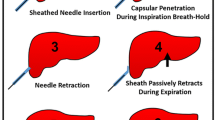Abstract
Although there has been a feasibility study of saline-enhanced radiofrequency ablation of the lung in rabbits, there has been no report on hypertonic saline-enhanced radiofrequency ablation of human pulmonary tumors or its complication. We report a case in which a large necrotic cavity was produced in the lung after hypertonic saline-enhanced radiofrequency ablation of recurrent metastatic tumor from hepatocellular carcinoma. Although hypertonic saline-enhanced radiofrequency ablation is powerful and efficient in local ablation, it is difficult to predict the exact extent of ablation, especially in the lungs. This can be dangerous, as there is a high chance of producing an ablation area much larger than expected and, hence, major complications. Special attention is required not to overablate while using this technique.

Similar content being viewed by others
Reference
Ni Y, Miao Y, Mulier S, Yu J, Baert AL, Marchal G (2000) A novel “cooled-wet” electrode for radiofrequency ablation. Eur Radiol 10:852–854
Boehm T, Malich A, Goldberg SN, Reichenbach JR, Hilger I, Hauff P, Reinhardt M, Fleck M, Kaiser WA (2002) Radio-frequency tumor ablation: Internally cooled electrode versus saline-enhanced technique in an aggressive rabbit tumor model. Radiology 222:805–813
Schmidt D, Trubenbach J, Brieger J, Koenig C, Putzhammer H, Duda SH, Claussen CD, Pereira PL (2003) Automated saline-enhanced radiofrequency thermal ablation: Initial results in ex vivo bovine livers. AJR Am J Roentgenol 180:163–165
Giorgio A, Tarantino L, de Stefano G, Scala V, Liorre G, Scarano F, Perrotta A, Farella N, Aloisio V, Mariniello N, Coppola C, Francica G, Ferraioli G (2003) Percutaneous sonographically guided saline-enhanced radiofrequency ablation of hepatocellular carcinoma. AJR Am J Roentgenol 181:479–484
Kettenbach J, Kostler W, Rucklinger E, Gustorff B, Hupfl M, Wolf F, Peer K, Weigner M, Lammer J, Muller W, Goldberg SN (2003) Percutaneous saline-enhanced radiofrequency ablation of unresectable hepatic tumors: Initial experience in 26 patients. AJR Am J Roentgenol 180:1537–1545
Lee JM, Kim SW, Li CA, Youk JH, Kim YK, Jin Z, Chung MJ, Lee MS (2002) Saline-enhanced radiofrequency thermal ablation of the lung: A feasibility study in rabbits. Korean J Radiol 3:245–253
Burdio F, Guemes A, Burdio JM, Navarro A, Sousa R, Castiella T, Cruz I, Burzaco O, Guirao X, Lozano R (2003) Large hepatic ablation with bipolar saline-enhanced radiofrequency: An experimental study in in vivo porcine liver with a novel approach. J Surg Res 110:193–201
Jin GY, Lee JM, Lee YC, Han YM (2004) Acute cerebral infarction after radiofrequency ablation of an atypical carcinoid pulmonary tumor. AJR Am J Roentgenol 182:990–992
Author information
Authors and Affiliations
Corresponding author
Rights and permissions
About this article
Cite this article
Kim, T.S., Lim, H.K. & Kim, H. Excessive Hyperthermic Necrosis of a Pulmonary Lobe after Hypertonic Saline-Enhanced Monopolar Radiofrequency Ablation. Cardiovasc Intervent Radiol 29, 160–163 (2006). https://doi.org/10.1007/s00270-004-0348-2
Published:
Issue Date:
DOI: https://doi.org/10.1007/s00270-004-0348-2




